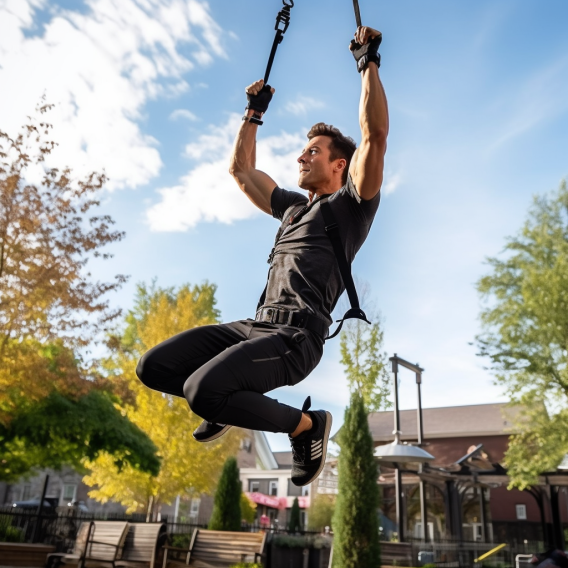In the modern world, where busy schedules and limited access to gyms have become the norm, the concept of bodyweight workouts has gained immense popularity. These workouts offer a versatile and effective way to stay in shape, build strength, and improve overall fitness without the need for expensive equipment or a gym membership. With nothing more than your own body as resistance, you can create a full-fledged workout routine that can be tailored to your fitness level and goals.
In this comprehensive guide, we will delve into the world of bodyweight workouts, exploring the science behind them, the benefits they offer, and a variety of exercises suitable for all fitness levels. Whether you’re a fitness enthusiast looking for new workout ideas or someone just beginning their fitness journey, this article will provide you with the knowledge and inspiration to get started with bodyweight training.
The Science Behind Bodyweight Workouts
Before we dive into the specific exercises, it’s essential to understand the science that underpins bodyweight training. The effectiveness of bodyweight workouts lies in the principles of resistance and adaptation.
1. Resistance: When you perform bodyweight exercises, you’re essentially using your own body as resistance. Your muscles have to work against this resistance to perform the movements, and this resistance can be adjusted by altering the leverage or angle of your body.
2. Adaptation: As your muscles work against resistance, they undergo microscopic damage. This damage, known as microtrauma, triggers the body’s natural repair process, which results in muscle growth and strength improvement. Over time, your body adapts to handle the resistance more effectively, leading to increased strength and endurance.
Benefits of Bodyweight Workouts
Bodyweight workouts offer a plethora of benefits, making them an attractive option for individuals of all fitness levels. Here are some of the advantages you can expect from incorporating bodyweight exercises into your fitness routine:
1. Convenience: One of the most significant advantages of bodyweight workouts is the convenience they offer. You can perform these exercises anywhere – in your living room, at a park, or even in a hotel room while traveling. There’s no need for special equipment or a gym.
2. Cost-Effective: Gym memberships and fitness equipment can be expensive. Bodyweight workouts are budget-friendly as they require no investment in equipment. All you need is your body and a little space.
3. Versatility: Bodyweight exercises can be modified to suit any fitness level. Whether you’re a beginner or an advanced athlete, you can adjust the intensity and complexity of the exercises to meet your needs.
4. Full-Body Engagement: Many bodyweight exercises engage multiple muscle groups simultaneously, providing a full-body workout in a shorter amount of time.
5. Functional Strength: Bodyweight workouts focus on functional movements that translate to real-life activities. This helps improve your overall strength and mobility.
6. Core Strengthening: Many bodyweight exercises emphasize core stability and strength, which is essential for good posture and overall body support.
7. Injury Prevention: Bodyweight exercises often involve natural movements that reduce the risk of injury associated with using heavy weights or complex machines.
Getting Started with Bodyweight Workouts
Now that we’ve established the benefits of bodyweight workouts, let’s explore some effective exercises that use your own body for resistance. These exercises can be combined to create a well-rounded workout routine. Whether you’re looking to build strength, increase flexibility, or improve endurance, there’s a bodyweight exercise for you.
*Push-Ups:* Push-ups are a classic bodyweight exercise that targets the chest, shoulders, and triceps. They can be modified to make them easier or more challenging, making them suitable for all fitness levels.
*Squats:* Squats work the lower body, including the quadriceps, hamstrings, and glutes. They also engage the core for stability.
*Lunges:* Lunges are excellent for targeting the quadriceps and glutes while also improving balance and coordination.
*Planks:* Planks are a core-strengthening exercise that also engages the shoulders, chest, and back. Holding a plank position for extended periods can greatly improve core endurance.
*Burpees:* Burpees are a full-body exercise that combines squats, push-ups, and a jump, providing both strength and cardio benefits.
*Mountain Climbers:* This exercise elevates your heart rate and works the core, shoulders, and legs. It’s an excellent addition to high-intensity interval training (HIIT) routines.
*Leg Raises:* Leg raises target the lower abdominal muscles and help improve core strength.
*Pull-Ups:* If you have access to a pull-up bar, this exercise is a fantastic way to target the upper body, especially the back and biceps.
*Bicycle Crunches:* These crunches work the obliques and help improve core strength and flexibility.
*Superman:* The superman exercise targets the lower back and is great for improving posture and preventing back pain.
*Bridges:* Bridges strengthen the glutes, lower back, and hamstrings, aiding in overall lower body strength.
*Wall Sits:* Wall sits are excellent for building leg strength and endurance, particularly in the quadriceps.
Building Your Bodyweight Workout Routine
Creating a bodyweight workout routine is a simple and customizable process. Here’s a step-by-step guide to help you get started:
1. Set Clear Goals: Determine what you want to achieve with your bodyweight workouts. Are you looking to build muscle, lose weight, or improve endurance?
2. Choose Your Exercises: Select exercises that align with your goals. For muscle building, focus on resistance-based exercises like push-ups and squats. For weight loss, incorporate more high-intensity exercises like burpees and mountain climbers.
3. Create a Weekly Schedule: Plan how often you’ll work out. Three to four times a week is a good starting point, but adjust based on your fitness level and availability.
4. Establish Sets and Repetitions: Determine the number of sets and repetitions for each exercise. Beginners might start with 2-3 sets of 10-12 repetitions, while more advanced individuals can increase the intensity and volume.
5. Incorporate Cardio: To enhance your workout, include cardio intervals like jumping jacks or high knees between strength exercises. This will elevate your heart rate and burn more calories.
6. Progression: As you become more comfortable with your routine, gradually increase the difficulty of your exercises. This can be done by adding repetitions, sets, or more complex variations.
7. Recovery: Don’t forget the importance of rest and recovery. Allow your muscles to heal and adapt to the exercises by giving yourself adequate rest between workouts.
Conclusion
Bodyweight workouts offer a simple yet highly effective means of improving your physical fitness without the need for expensive equipment or gym memberships. Whether you’re a beginner or an experienced fitness enthusiast, these exercises can be tailored to suit your individual needs and goals. By understanding the science behind bodyweight workouts and the numerous benefits they provide, you’re well-equipped to embark on a journey to a healthier and stronger you. So, lace up your sneakers, find a comfortable workout space, and get started on your path to improved fitness through bodyweight exercises.



